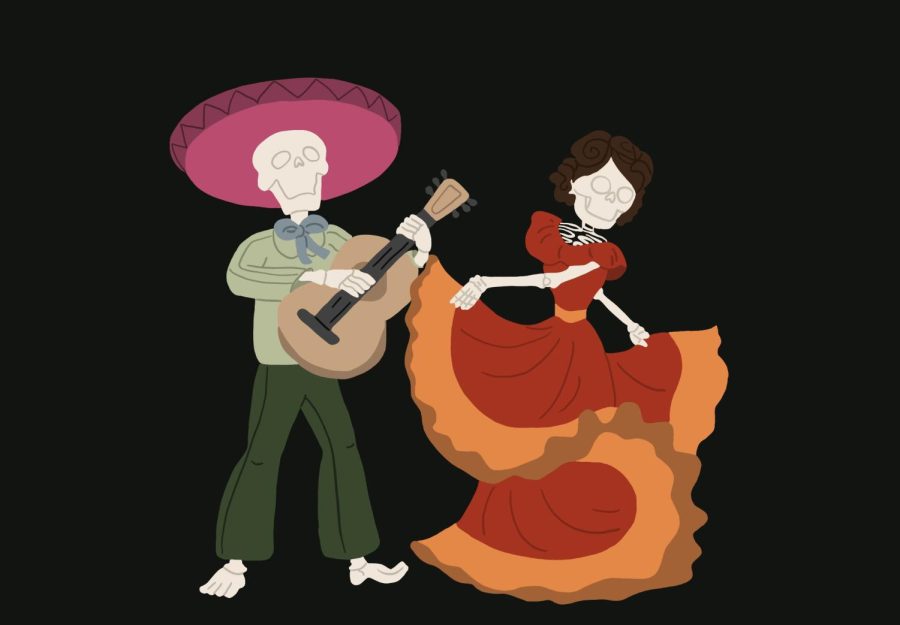OMA Día de los Muertos Showcases Culture, History and Crafts
A collection of colorful pan dulce, Mexican hot chocolate and ofrenda decor brought a previously dull room in Chardin Hall to life last week. The collection of food and crafts was paired with an educational documentary and other programming organized by the Office of Multicultural Affairs (OMA) to teach students about the history of Día de los Muertos. Students learned about the significance of the holiday and how it can help people deal with grief. One tradition attendees were treated to was the making and decoration of ofrendas, elaborate altars which welcome the souls of the dead back to the world of the living to connect with their loved ones.
The celebration of Hispanic Heritage Month, which takes place Sept. 15 to Oct. 15, along with the holiday’s conflation with Halloween, inspired Graduate Program Coordinator at OMA Gabby Rios to host the event.
“We have three values at OMA—one of them is cultural education,” Rios said. “With September being Hispanic Heritage Month, and a movie like Coco that really gave wide exposure to Day of the Dead, we really wanted to provide an educational piece that would give students from different backgrounds more context about the holiday and its significance.”
Aside from arts and crafts, small informational pamphlets were distributed that educated students on the specifics of the tradition. The central focus of Día de los Muertos is the remembering of ancestors, laughing in the face of death and preserving pre-colonial traditions. While the holiday has Mesoamerican roots, it is also informed by Spanish Catholic settlement. It takes place on All Souls Day, the Catholic feast day in which the faithful commemorate those who have been laid to rest.
The pamphlets, designed by Rios, highlighted ideas and traditions of the Indigenous conception of the holiday. One of these traditions is the intricate altars built to welcome the spirits to the living world. The ofrendas are typically decorated with marigolds, foods and drinks, candles, salt, photos of the deceased and a multitude of other elements that vary by culture. Not only do the altars have personal significance to families, but they also hold a spiritual element that traces back hundreds of years.
“Colonization has impacted how the holiday is celebrated today. Indigenous cultures viewed the Earth as an extremely significant part of our lives. For instance, almost every item on the ofrenda connects to one of the elements,” Rios said. “Marigolds are ruffled by the wind, sage and candles represent fire, water is, of course, water and salt and food represent the earth. Knowing the significance of these items is extremely important to anyone who wants to know the history of this holiday.”
OMA is working to spread knowledge about the holiday. Cai Robinson, a first-year photography major, discussed the importance of cross-cultural education.
“Having different perspectives allows us to learn more about other people. Learning about how people are different from us can allow us to relate and share spaces. A great example of this is the appropriation of the holiday,” Robinson said. “Sometimes it’s just viewed as ‘Mexican halloween,’ or a chance to dress up and drink tequila. When you actually learn about the holiday, though, it becomes clear how far from the truth that is.”
The way Día de los Muertos grapples with grief and death hits a personal note for Eris Gleeson, a first-year criminal justice major, who discussed how their grief was impacted by the holiday.
“I had a friend pass away recently,” Gleeson said. “It was scary and hard, but learning about the way grief is processed through this holiday was really helpful. Being able to think about how I would celebrate my friends life through an ofrenda, rather than participating in an all black procession was really comforting. Death is a natural part of life, and we should appreciate the time here while we have it.”
Día de los Muertos is a culturally and spiritually significant holiday in modern Mexican culture, where around 80 percent of people participate in the celebration. It is an example of a faith practice which blends Indigenous and Catholic spirituality, and allows millions of people to process personal grief, connecting us to the natural world and those who are no longer with us. It can also have a great personal benefit as well, introducing one to new views of the world that can help process personal grief, connect us to the natural world and celebrate those no longer with us.


